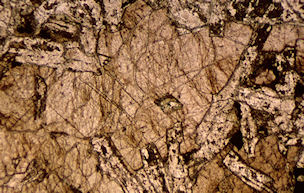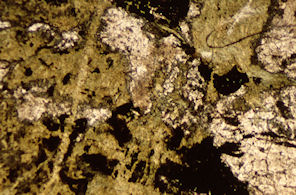
Figure 25: Long Rock Sample LNR001b in PPL and XPL (Field of View (FoV) 4mm). Click image to enlarge
Four thin-sections from the greenstone exposure at Cudden Point within the Mylor Slate Formation have plentiful clinozoisite and epidote, which sets them aside from all axe thin-sections reviewed so far. In addition, and uniquely within the Cudden Point thin-sections, one (CUD003) contains primary magmatic, brown, amphibole, which is not seen in any examined thin-section, is coarse-grained with some altered, partly ophitic pyroxenes up to 7mm long, and is unlike any Group I, Ia or III axe thin-section examined.
The groundmass of the Porthleven exposure within the Mylor Slate Formation has been completely altered to fine-grained clays, micas and amphiboles, with albite (quartz?) as larger grains randomly intermixed. Bright red rutile grains are present in part of the thin-section. In one of the two thin-section (PLN002), 2mm-sized, almost square, crystals of plagioclase show fine lamellar twinning. The rest of the thin-section contains mats of fibrous radiating bundles of amphibole and mica. Neither texture has been seen in an axe thin-section examined in this work.
Thirteen thin-sections were derived from samples collected near Perranuthnoe. All pyroxene in thin-section TRE001 (from near Trenow Cove) has been completely replaced by a granular–fibrous mat of amphibole and chlorite. Feldspars are only suggested by virtue of polymorphs of sericite. Apatite is readily visible as fine acicular grains, with isotropic hexagonal basal sections. The alteration, especially the matted amphibole/chlorite, is not seen in any axe thin-section.
The five thin-sections, from five samples of greenstone material collected from the cliff on the north side of Trenow Cove, are dominated by 2-3mm sized plagioclase feldspar, sometimes showing alignment of grains and is reminiscent of thin-sections from the dioritic exposure at Carn Gwavas (see below), suggesting this rock is more intermediate than basic. Coarse apatite grains are plentiful, a further feature not seen in axe thin-sections.
A thin-section (TRE005) from a large cobble off the beach at Trenow Cove is similar to that collected near Trenow Cove (see above); however, there is a range of clinozoisite–epidote and plentiful large apatite grains. Rare relicts of pyroxene and the shape of the fibrous mats of amphibole replacing pyroxene suggest a once ophitic nature. This texture, plus the abundant epidote, is not seen in any axe thin-section so far reviewed.
A quarry 0.5km east of Trenow Cove provided three greenstone samples. Fibrous mats of amphibole and chlorite are found in two thin-sections, with the exception that in one (TRE010) the mats have an overall brown colouration. Otherwise these two sections are similar and have a texture not seen in axe thin-sections examined in this work. Two sections (TRE011A and B) come from the same rock sample and demonstrate the variation in greenstone rocks over a few cm. One (TRE0011A) is heavily chloritised with no pyroxene or feldspar visible, instead there is groundmass of fine fibrous amphibole and granular sericite, with apatite and epidote. The other (TRE011B) has uralitised partly ophitic clinopyroxenes surrounded and penetrated by slightly altered mm-sized laths of lamellar twinned plagioclase feldspars, although the groundmass of both does contain a similar proportion of apatite. This grain size and level of abundance of epidote is not seen in any axe thin-section. The final sample (TRE012) is similar to one collected from Trenow Cove (TRE003), with the exception that it has been heavily chloritised leaving smaller feldspars in the groundmass. This level of distinctive chloritisation has not been seen in any axe thin-sections reviewed in this work.
Fibrous amphibole, probably after pyroxene and sericite after feldspar, dominate a sample collected from Perran Sands (TRE013), with the latter as pseudomorphs of plagioclase (rare relicts of lamellar twinning are still visible). Veins filled with radiating, almost spherulitic, fine amphibole are seen across the section. Fine apatite is visible throughout, along with a few small epidote grains. This texture has not been seen in any axe thin-section.
In summary, none of the 13 thin-sections from greenstone samples collected from near Perranuthnoe are similar to any IPG Group I, Ia, III and IIIa axe thin-sections. This is surprising, since IPG Group III is provenanced to the same quarry that provided samples TRE001, 010, and 011a and b. It is concluded that the exposure must have variable texture and degree of alteration and, as illustrated by sample TRE011a and b, the actual source for Group III axes could have been quarried away after the matching specimen was taken.
Almost fresh ophitic clinopyroxenes, up to 4mm long, are surrounded and penetrated by smaller plagioclase feldspar laths and are seen in two of the four samples collected from Long Rock, within the Mylor Slate Formation of Penzance Bay. Granular chlorite/amphibole is seen in place of some clinopyroxene. The freshness of pyroxenes and feldspars is not seen in any axe thin-section that has been examined. Pyroxenes in one sample (LNR004), once to 4mm and ophitic, have been completely replaced by granular to fibrous mats of amphibole showing first order birefringence and oblique extinction. Feldspars are similarly as altered, but to sericite/amphibole. The type of alteration, but not mineralogy, seen in LNR001b, 4 and 4a, is similar to GpI-5 and 11.

Figure 25: Long Rock Sample LNR001b in PPL and XPL (Field of View (FoV) 4mm). Click image to enlarge
The remaining two Long Rock samples are very fine-grained and are both similar. The total lack of opaque grains and any visible pseudomorphic grain structure makes them different from any axe thin-section examined in this work.
Samples from coastal exposures south of Penzance, near Carn Gwavas (PEN001 and 2 and 2a-b) are almost totally a mixture of plagioclase and orthoclase feldspar. Biotite mica is plentiful as granular patches surrounding the feldspar grains. Amphibole is seen within cracks. The texture and composition of these samples has not been seen in the axe thin-sections.
The sample from Penlee Point (PEN003) has plentiful, acicular actinolite to bladed hornblende scattered throughout the groundmass. Large eroded opaque grains reveal a polygonal skeleton and elongate, fine crystals of apatite are also visible. The lack of pyroxene, presence of mats of fibrous to tabular amphibole and the other petrographic features seen in this sample (PEN003), are similar to those found in GpI-6.

Figure 26: Penlee Sample PEN003 in PPL and XPL (FoV 4mm). Click image to enlarge
Small, <0.25mm diameter, grains of bright (xpl) amphibole seen in a greenstone sample collected from an exposure on the shore near Mousehole harbour (PEN004). Possibly containing hornblende, it suggests the rock once contained non-ophitic fine euhedral pyroxenes. The groundmass is completely altered to clay and very fine acicular actinolite. Overall the texture seen in this Mousehole sample (PEN004) is similar to GpI-6 and MM4 series, but with less of the secondary biotite.
Fine granular hornblende and quartz dominate the two Polkinhorne samples (PLK001 and 2), whereas the third (PLK003) has equal quantities of coarse-grained biotite and quartz. None of these three thin-sections resemble any axe thin-section examined in this work.
The three sample from Tredavoe are all hornfelsed, with a fine granular matrix overprinting a once coarser grained texture. In two (TDO001/2) relict clinopyroxenes are readily visible, along with heavily altered feldspars. Large quantities of coarse apatite are also present, unlike the third sample (TDO003), which has less apatite and the pyroxenes are almost totally altered to a fine granular mass of chlorite and biotite. In all three thin-sections ilmenite has been altered to leucoxene. The granular, hornfelsed texture has not been seen in any axe thin-sections examined in this work.
In summary, the similarities between Penlee Point (PEN003) and Mousehole (PEN004), (and MM4 – see below) and axe Group I-6, and the textural similarities between Long Rock samples (LNR001a, 4 and 4a) and GpI-5 and GpI-11 are the closest seen between greenstone exposures found in Mounts Bay, Southern Cornwall, and axe thin-sections. These findings, therefore, support the IPG findings that IPG Group I may have originated on the west side of Mounts Bay. However, the similarities above only account for 17 of the 119+17 IPG Group I and Ia axe thin-sections reviewed.
© Internet Archaeology/Author(s) URL: http://intarch.ac.uk/journal/issue26/23/3.3.html
Last updated: Wed Jul 29 2009